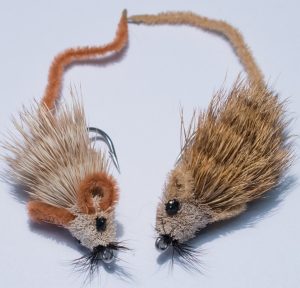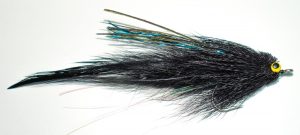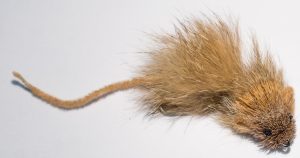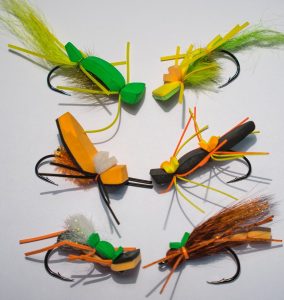Dorado Fly Patterns
Types of Golden Fly Patterns
In most cases, golden dorado prefer dark streamers that produce visible silhouettes. Nervertheless, there are situations when carrying a mixture of brighter colors can be effective. So don’t be afraid to experiment across the color spectrum. All flies should be tied on stout 1/0 to 3/0 hooks. Streamers can be tied from 4 to 6 inches long, or longer. However, it’s important that they’re light enough to cast. For the real big stuff, we recommend hydrophobic materials that shed water and therefore cast farther than a water-soaked materials. In order to make your flies more durable, add glue or epoxy throughout the tying process if necesary.
Andino Deceiver
Info: Andino Deceivers is arguable one of the best Golden Dorado flies around today. The reason they are so effective is the combination of 2 things: Firstly the bucktail head pushes a lot of water and secondly the flexible hackle gives the fly a good action.
Materials: Long Black/Yellow/Black and Orange/Black and Red/Black and Purple Hackles, Flashabou, Peacock hurl, Bucktail black, yellow dumbbell eyes, 2/0 to 3/0 or 210 Denier
How to Fish: This can be fished with either floating or sinking lines, retrieving with long consistent strips. However when wading the fly can also be fished on the swing whilst twitching the fly as it moves. This can be particularly effective with sinking lines.
When to fish: This can be fished at anytime as it creates a strong contrast with the sky, even when it is cloudy.
Where to fish: This can be fished in any location for Golden Dorado.
Tie: Begin with a base layer of thread and attach the dumbbell eyes by crossing the line back and forth across the eyes. Tie 4 hackles midway down the shank making sure to separate the hackles in 2 and attach with the convexed side facing away to give the tail more movement. Then add flashabou down each side of the fly no longer than the hackles, however is important not to add to much flash. After take around 7-8 peacock hurls and attach them to the top of the fly just behind the eyes leaving enough room for the ghostwriter hausarbeit jura. Attach the bucktail by taking a small bunch and remove all the short hairs, then stack fibers. Tie the bucktail (exposing a third towards the hook) by making a few lighter turns, before tightening and moving the fibers all the way round the hook. Finish with a whip finish at the eye of the fly and trim the fibers to shape the head.
Synthetic Streamers
Info: The synthetic are a more recent innovation of the deceiver and have proven extremely effective. The fibers can be used and molded into a number of different profiles to push more water.
Materials: Red and black EP Fibers, red Angel hair, Large plastic eyes, 1/0 to 3/0 or 210 Denier Thread, hook.
How to Fish: This can be fished with either floating or sinking lines, retrieving with long consistent strips. However when wading the fly can also be fished on the swing whilst twitching the fly as it moves. This can be particularly effective with sinking lines.
When to fish: This can be fished at anytime as it creates a strong contrast with the sky, even when it is cloudy.
Where to fish: This can be fished in any location for Golden Dorado.
Tie: Begin with a base layer of thread and gather a small bunch of fibers together of each colour. Tie the 2 colours top and bottom, towards the end of the shank and trim off the excess. Continue this process up the shank of the hook making the fibers shorter each time adding in a little angel hair each time. When the eye of the hook is reached, complete with a whip finish. Trim the fly down to create a tapered profile. Finish by gluing eyes on each side.
Poppers

Info: The popper has become popular with a number of different species however has become very effective with Golden Dorado. Due to the amount of noise and disturbance it creates, it will often make Golden Dorado extremely aggressive towards them.
Materials: Block foam, long chenille, Marabou, Crystal flash, Hackles, stick-on eyes, 1/0 to 3/0 or 210 Denier Thread and hook.
How to Fish: This must be fished with a floating line only. Using sharp aggressive strips is important to create as much disturbance on the surface as possible.
When to fish: This can theoretically be fished all the time, however, normally it will not be as productive as a streamer. The best time to use this is when the fish become more active.
Where to fish: This can be fished in any location for Golden Dorado.
Tie: Begin with a base layer of thread to the end of the shank. Tie the hackles at the end of the shank and add in 3 pieces of crystal flash each side of the fly no longer then the hackles. Continue by adding marabou in front around the hook to create some profile. Use the long chenille and wrap round the hook to give the fly some flash. Complete with a whip finish. Mold the foam into the popper shape before creating a slit to put it on the hook. Add glue generously on the hook and inside the popper and attach to the hook making sure a large enough gape is open to hook the fish. Let dry and add eyes with glue.
Articulated Mouse
Info: The mouse fly has become a very effective Golden Dorado pattern as it is a large meal item and pushes a lot of water. Ranging from around 4-5 inches it has become very popular pattern.
Materials: Chenille, Zonker strips, Bucktail, 1/0 to 3/0 or 210 Denier Thread, 40lb Wire Tippet and TMC 811S hook.
How to Fish: This can be fished with a floating or sinking line, however fishes better with a floating line. Can either be fished with very short and rapid strips or a long strip but retrieved slowly.
When to fish: This can theoretically be fished all the time, however, normally it will not be as productive as a streamer. The best time to use this is when the fish become more active.
Where to fish: This can be fished in most locations that have rodents.
Tie: Firstly the hook section of the articulated fly must be tied. Begin with a base layer of thread to the end of the shank and tie in the chenille tail around 1-2 inches long. Then apply the tan Zonker Rabbit Fur by first attaching it and winding the bobbin to the other end of the shank. Wrap the Zonker Rabbit Fur up the shank of the hook pulling the fibers back with each wrap. Complete with a whip finish to secure. For the front section begin again with a base layer of thread and attach to the front shank using 40lb wire tippet. Create a loop through the eye of the hook and tie it down to the front shank. Then continue using the Zonker Rabbit Fur again in the same way half way up the shank. Attach the bucktail by taking a small bunch and remove all the short hairs, then stack fibers. Tie the bucktail by making a few lighter turns, before tightening and moving around the hook. Tie in the ears by creating loops and add more bucktail in front to create the head. Use a few black bucktail fibers in each side of the hook to create whiskers. End with a whip finish before trimming the bucktail to shape the head. Add 2 eyes with either a black permanent marker or melt black plastic.
Mouse

Info: The mouse fly has become a very effective Golden Dorado pattern as it is a large meal item and pushes a lot of water. Ranging from around 2-4 inches it has become very popular pattern
Materials: Chenille, Bucktail, 1/0 to 3/0 or 210 Denier Thread and TMC 811 hook.
How to Fish: This can be fished with a floating or sinking line, however fishes better with a floating line. Can either be fished with very short and rapid strips or with a long strip but retrieved slowly.
When to fish: This can theoretically be fished all the time, however, normally it will not be as productive as a streamer. The best time to use this is when the fish become more active.
Where to fish: This can be fished in most locations that have rodents.
Tie: Begin with a base layer of thread to the end of the shank and tie in the chenille tail. Attach the bucktail by taking a small bunch and remove all the short hairs, then stack fibers. Tie the bucktail by making a few lighter turns, before tightening and moving around the hook. Tie in the ears by creating loops and add more bucktail in front. End with a whip finish before trimming the bucktail to shape ghostwriting kosten. Add 2 eyes with either a black permanent marker or melt black plastic.
Titanic Slider
Info: Although the Titanic Slider does not resemble anything in particular it has become a very effective fly due to the amount of water it moves on the surface. With this dark silhouette it makes a very clear shape for Golden Dorado to attack.
Materials: EP Fibers, Flashabou, Marabou, Foam Sheets, 1/0 to 3/0 or 210 Denier Thread, and Owner AKI Hook.
How to Fish: This can only be fished with a floating line. This can be stripped, however the most effective way to fish this is by swinging as it creates a consistent wake. Cast across the river at a 45-degree angle and swing the fly across the river.
When to fish: The best time to use this is when the fish become more active. For example: during last light and early morning. However should also be used during periods of intense surface activity or in shallow water.
Where to fish: This can be fished in most locations.
Tie: Begin with a base layer of thread to the end of the shank. Take a small bunch of EP fibers and flashabou, and work them together before tying them into the end of the shank. Take a full marabou feather and attach in front of the EP fibers and continue to wind the thread ¾ up the shank. Wrap the marabou up the shank pulling the fibers back on each turn. Tie the marabou feather off and whip finish. Cut and attach the 2 identical pieces of foam and stick together. Glue the V together behind the eye of the hook first before gluing the rest to the shank of the fly.
Large Terrestrials
Info: This style of fly has often been used for trout in the past however these more robust and larger patterns have become very effective for Golden Dorado. Around 1-3 inches long these flies push a lot of water and Golden Dorado have become very receptive to them.
Materials: Foam Block, 2mm Foam Sheet, Rubber legs, Chenille, 1/0 or 210 Denier Thread, Buck tail, Hackle, Craft Fur, TMC 600SP Hook. Smaller hooks also work well for this type of flies, as long as the hook is a strong one, and they are lighter to cast.
How to Fish: This can only be fished with a floating line and works well with very small and quick strips. This can also be fished by swinging however is more effective when stripped as the front pushes a lot of water.
When to fish: The best time to use this is when the fish become more active. However should also be used during periods of intense surface activity or in shallow water. This can be used at anytime, although the activity will not be as prolific.
Where to fish: This can be fished in all locations, however works best when fishing near trees and plants as these areas have the largest abundance of these types of flies.
Tie: This fly is tied by first laying a base layer of thread down the shank to the end. Work from the back of the fly to the front beginning with adding the tail first if required. Depending on whether the body is tied all the way down the body, tie the foam in first before adding the body. The body can be made out of a variety of different materials such as chenille, hackle, dubbing and short marabou. Tie the foam down behind the hook leaving enough room to thread line through the eye of the hook. Add other features such as foam pieces or buck tail on top to create wings or wing cases. Small amounts of flash in the fly can add to the bwl hausarbeit schreiben lassen.
Diver

Info: The Diver is a fly that fishes subsurface moving from above to below the surface of the water between strips. It is an extremely effective fly creating a lot of disturbance. This fly can often imitate frogs and can be very productive in areas with high abundance of frogs such as the Ibera Wetlands.
Materials: Bucktail, Hackles, Crystal Flash, Rubber legs, Plastic Eyes, 1/0 to 3/0 or 210 Denier Thread, and TMC 600SP Hook.
How to Fish: This can only be fished with a floating line and fished like a popper with long sharp strips.
When to fish: The best time to use this is when the fish become more active. However should also be used during periods of intense surface activity or in shallow water. This can be used at anytime, although the activity will not be as prolific.
Where to fish: This can be fished in all locations, however works best in shallower and clearer waters.
Tie: This is tied with a base layer of thread to the end of the shank before tying in 4 hackles and a small bunch of crystal flash on each side. Take a clump of bucktail and begin to tie the bucktail in by making a few lighter turns, before tightening and moving around the hook. Add the rubber legs on each side before adding 2-3 more clumps of bucktail. The colours can be varied as preferred.





